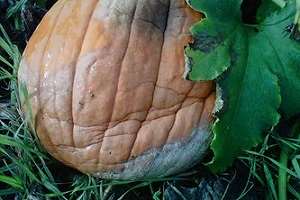
Why is this disease so bad?
Phytophthora has the ability to stay in your soil for seven or more years because it produces survival structures enabling it to survive even when peppers and cucurbits crops are not planted. It waits “dormant” in the soil until a susceptible crop is planted and the soil moisture conditions are right. Even if you have Phytophthora in your soils, in a dry year, you might not experience any losses, however when the soil moisture becomes excessive at any point in the season, Phytophthora goes to work.
In pumpkin and winter squash fields the first symptom you may notice is your plants are starting to wilt, especially in the low areas of your field. You will then see fruit that is touching the soil start to rot. The rot will start where the fruit touches the soil and slowly move up the fruit. The rot is soft, giving a water-soaked appearance, and the fruit will then collapse. You may also notice a white growth on the rotting fruit. These are the reproductive structures (or spores) of Phytophthora that help it spread in the field especially when it is wet.
There are several soil borne diseases that affect vegetable crops but Phytophthora is the only one that has the white mold on the rotting fruit. It often looks like a dense coating of powder sugar on the fruit surface. The symptoms in pepper fields are similar but you will probably see the white mold growing on the stem close to the soil line of wilted plants before you will see the fruit rot. Infected fruit often breaks down quickly when stored in bins.
If that is not bad enough, Phytophthora has the ability to live in water including irrigation water. If water runs from an infected field it will carry the Phytophthora spores with it. If that water ends up in a pond used for irrigation the spores can be distributed to all of the fields being irrigated from that pond. It also moves with soil. I’ve seen Phytophthora moved onto a previously clean farm when a transplanter was borrowed from an infected farm. It can also move with other farm equipment also, like sprayers or even on muddy boots.
Another common way Phytophthora moves onto a farm is on infected fruit. If you take possession of produce from another farm, never put any of the unsold fruit in your fields, especially if it is starting to decay. It is not uncommon to see Phytophthora in the fields closest to the packing shed where fruit were casually discarded.
Management
Do everything you can to keep it from coming onto your farm. If you share equipment take the time to thoroughly clean it in a non-production area before taking it to your field. That includes irrigation pumps, lay flat, stakes, etc. If you are sharing equipment with a farm that has had a history of Phytophthora, you may want to rethink that. Don’t put decaying produce from other farms in your fields. Maintain a good level of organic matter in your soil. Beneficial micro-organisms will compete with the disease causing organisms.
What can you do if Phytophthora is already on your farm? Do what you can to avoid your soil becoming saturated. Raised beds help. Deep tillage, like subsoiling, allows excess water to drain away, reducing the opportunity for infection. Minimize water between fields by planting grass strips and maintaining field access roads. Use tolerant varieties when available. Tolerance means the infection will be less severe or spread more slowly, not that an infection can’t happen.
Currently, the more tolerant varieties of pepper include Paladin, Aristotle, Vanguard and Intruder. In university trials, Revolution and Declaration have shown more variability in tolerance depending on the season. Hard-rind pumpkins are slightly less susceptible. What you shouldn’t do is assume that you can control this disease with fungicides. Fungicides may help reduce the severity of the infection but they are not a silver bullet. One grower used Orondis Gold 200 tank mixed with Ridomil Gold (Section 2ee label for this tank mix in PA and other states) through his drip irrigation system the first week in August and felt it helped keep the Phytophthora from spreading the rest of the summer.
- Learn to identify the symptoms of Phytophthora blight.
- Find out if it is on farms near you. Be proactive in keeping it off your farm. Management tools are limited once it is established.
- Incorporate the good soil management practices mentioned.
- Carefully clean your equipment before moving to a Phytophthora free field.
- Dispose of decaying produce where it can’t infect new areas.
- Use tolerant varieties when they are available.
- Manage irrigation to avoid over watering.
- Fix leaks quickly.
- Keep field runoff from entering irrigation ponds.
Using Fungicides
Be ready to use fungicides like Revus, Ranman, Presidio, Forum, Tanos or Orondis Gold 200, that work against oomycete diseases. If making multiple fungicide applications, make sure to rotate between different FRAC codes for resistance management.
Some Phytophthora strains can be managed with mefenoxam, the active ingredient in Ridomil Gold, however, research conducted in Montour County in 2013 showed that mefenoxam had no effect on managing the Phytophthora on that farm. This has also been observed in many fields in New York. Research on the ability of fungicides to manage Phytophthora is ongoing. Check the most recent Mid-Atlantic Vegetable Production Recommendations for the latest recommendations.
Source: psu.edu